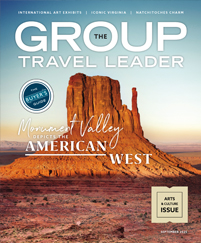Tell a group of people they are going camping, and you will see excitement, horror and every reaction in between. Some will picture being surrounded by the quiet serenity of nature; others will envision bugs, sleeping on the ground and — gasp! — a lack of modern bathrooms.
The hassles have kept many groups from even attempting this a camping trip. But what if you could go camping without any of the negatives?
That is where “glamping” comes in. Short for “glamorous camping,” glamping creatively rethinks camping to keep the desired oneness with the outdoors while subtracting the inconvenience and the discomfort. Glamping guests can enjoy the comforts of a hotel while staying connected to the surrounding environment.
“When people think of camping, they might think of a tent,” said Linda Clark, director of sales for Glamping.com. “You might be in a tent with glamping, too, but that doesn’t mean you are in a sleeping bag. You might have a luxurious bed with a high thread count and a butler on staff.”
Many consider glamping a form of experiential travel since it immerses visitors in the destinations they visit. And like experiential travel, glamping has taken off in popularity with individuals and groups across the country.
Glamping Trend
Though the buzz about glamping has grown in the United States in recent years, the idea of camping without sacrificing luxury has existed for a while. Early-1900s European and American travelers camping in Africa did not want to forgo their upscale lifestyles. Thus, the concept of glamping was born.
“Africa has been successfully doing glamping since the Livingston era,” said Dan Austin, founder and president of Austin Adventures. “That’s what everyone’s trying to replicate. I’ve been to dozens of African camps, and all of them I would call luxury camping. They are a far cry from a regular camp.”
Based in Billings, Montana, Austin Adventures creates small-group adventure itineraries, including glamping safaris in Africa. On tours of Botswana, for example, groups stay in opulently furnished tented rooms with sweeping views of the surrounding floodplains.
Though luxury camping has gained ground in the United States only in the past decade, glamping has been in demand in Europe for a lot longer.
“Most people think the phrase glamping was coined in the United States,” said Clark with Glamping.com. “People in the United Kingdom have been using the term for the past 40 years.”
Over the years, glamping has evolved to include tepees, Airstream trailers, yurts, tree houses and many other unconventional structures enveloped by nature. An uptick in demand for these unusual accommodations has caused new glamping destinations to pop up across the world.
“When I started working at Glamping.com a year and a half ago, the word glamping was searched for in Google 130,000 times a month,” said Clark. “Now it is searched 145,000 times a month. So people are seeking it out more and more.”
Clark believes that people’s ongoing search for new experiences has contributed to glamping’s surge in popularity. The ability to immerse oneself in the glamping destination remains another selling point for those seeking experiential travel.
“Glamping gives groups the opportunity to come to a unique place and experience it up close,” said Daren Cole, general manager of Moab Under Canvas. “You show up, you have your site, and we take care of everything from there. You don’t have to lug your equipment there.”
Moab Under Canvas offers glamping sites that sit on a bluff overlooking Arches National Park. Groups staying there can soak in the 360-degree views of the Moab Desert instead of taking a quick picture and heading to the next location.
Besides the ease of connecting with the outdoors, nostalgia for previous camping experiences also plays a role in motivating potential glampers.
“I think a lot of people want to recover those camping memories from childhood,” said Mark Waltrip, COO for Westgate Resorts. “People don’t have long vacation times, so they have to figure out how to recapture those memories. Glamping helps them do that within a shorter time frame because they just have to show up and start having fun.”
Westgate River Ranch helps re-create those memories on 1,700 acres in central Florida. Guests can camp on a dude ranch that hearkens to the original settlers of Florida but has modern glamping amenities.









